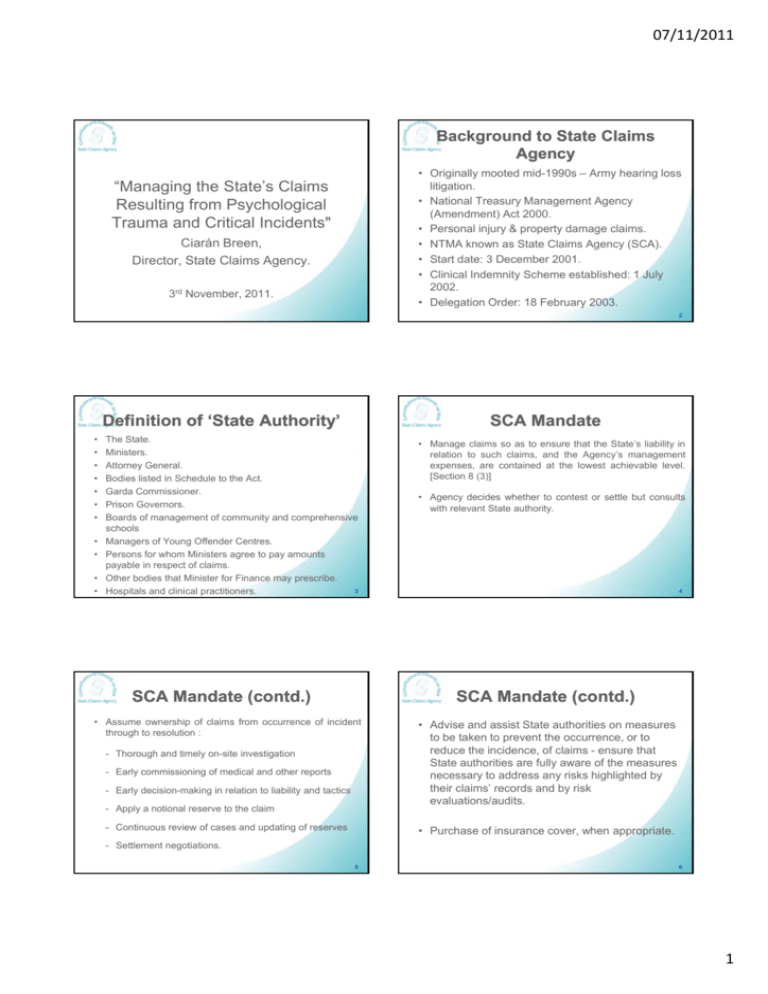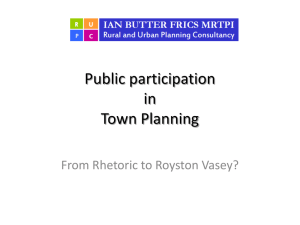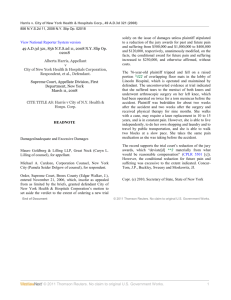Managing the State's Claims Resulting from Psychological Trauma
advertisement

07/11/2011 Background to State Claims Agency • Originally mooted mid-1990s – Army hearing loss litigation. • National Treasury Management Agency (Amendment) Act 2000. • Personal injury & property damage claims. • NTMA known as State Claims Agency (SCA). • Start date: 3 December 2001. • Clinical Indemnity Scheme established: 1 July 2002. • Delegation Order: 18 February 2003. “Managing the State’s Claims Resulting from Psychological Trauma and Critical Incidents" Ciarán Breen, Director, State Claims Agency. 3rd November, 2011. 2 Definition of ‘State Authority’ • • • • • • • • • • • SCA Mandate The State. Ministers. Attorney General. Bodies listed in Schedule to the Act. Garda Commissioner. Prison Governors. Boards of management of community and comprehensive schools Managers of Young Offender Centres. Persons for whom Ministers agree to pay amounts payable in respect of claims. Other bodies that Minister for Finance may prescribe. 3 Hospitals and clinical practitioners. SCA Mandate (contd.) • Manage claims so as to ensure that the State’s liability in relation to such claims, and the Agency’s management expenses, are contained at the lowest achievable level. [Section 8 (3)] • Agency decides whether to contest or settle but consults with relevant State authority. 4 SCA Mandate (contd.) • Assume ownership of claims from occurrence of incident through to resolution : - Thorough and timely on-site investigation - Early commissioning of medical and other reports - Early decision-making in relation to liability and tactics - Apply a notional reserve to the claim - Continuous review of cases and updating of reserves • Advise and assist State authorities on measures to be taken to prevent the occurrence, or to reduce the incidence, of claims - ensure that State authorities are fully aware of the measures necessary to t address dd any risks i k hi highlighted hli ht d b by their claims’ records and by risk evaluations/audits. • Purchase of insurance cover, when appropriate. - Settlement negotiations. 5 6 1 07/11/2011 Current Approaches to Awarding Damages Future Special Damages When assessing future special damages the courts make particular assumptions in relation to some relevant factors and contingencies to include: • The plaintiff’s likely life expectancy. • The fact that the plaintiff’s condition may deteriorate. • Cost of medical care/treatment and of medical aids and appliances. • Loss of earnings. • Tax rates on income. • Inflation rates. • Rate of return on the capital sum when invested. Damages awarded to compensate for personal injuries are intended to put the injured party in the same position he/she would have been in but for the wrong for which he/she is now getting compensation. - Restitutio in Integrum principle Lump Sum Payment Intended to compensate for all past and future losses. These losses include non-pecuniary loss (general damages) and pecuniary loss (special damages). 7 8 Psychiatric Damage • Nervous shock is the phrase commonly used by lawyers to describe cases of psychiatric damage. • Courts traditionally took the view that such injury only occurred to those possessing a nervous disposition and that persons of ordinary mental fortitude could not suffer from such an injury. • Courts’ attitude has been liberalised as evidenced in the change of phraseology: • Traditionally, courts were wary of recognising liability for negligently inflicted psychiatric damage. There were a number of reasons postulated for this scepticism, as follows: Faked/exaggerated claims. Measurability of damage. Floodgates argument. Attia -v- British Gas Plc [1988] QB 304 - Use of “psychiatric damage”. Development of the Tort of Psychiatric Damage • In Victoria Ry Commissioners -v- Coultas [1988[ 13AC 222, the court rejected the plaintiff’s claim for nervous shock when due to the defendant’s negligence a train almost hit her “a wide field being g opened p for imaginary g y claims” • In Byrne -v- Southern and Western Ry Co [1884] 26 LR 428, the plaintiff was awarded damages (£325) for nervous shock, in the absence of physical injuries, when a train crashed through the walls of the office. Become known as the “zone of danger” rule. The Alternative Doctrine • Plaintiffs who could succeed in an action for negligently inflicted psychiatric damage was expanded to: a) Those who came upon the immediate aftermath, and b) Had sufficient proximity of relationship with the victim. • In England these plaintiffs were referred to as secondary victims Hambrook -v- Stokes Bros [1925] 1 KB 141. Followed by Bell -v- Great Northern Railway Co [1890] 26 LR. 2 07/11/2011 Primary and Secondary Victims • As a result of this case, courts now recognised that not only was it reasonably foreseeable that a plaintiff physically involved in an accident would suffer nervous shock, it was also reasonably foreseeable that a parent of a child witnessing an accident involving that child would suffer nervous shock. • “Primary victims” were those involved in the accident. If physical injury was foreseeable, they could claim damages for psychiatric injury regardless of whether psychiatric damage was foreseeable or not. • “Secondary victims” were those not directly involved in the accident. The courts were willing to recognise their claims in limited circumstances. • House of Lords set limits on who could claim for psychiatric injury and were not directly involved in the accident. McLoughlin -v- O’Brien [1983] AC 410. McLoughlin -v- O’Brien • Plaintiff’s husband and 3 children were involved in a RTA. Plaintiff (the mother) was told of the accident by a passing motorist. She attended the hospital where she witnessed her family members in great distress. One child had died. She suffered immediate shock. • Court set parameters as follows: a) A close relationship of love and affection. b) Closeness to the accident in time and space. c) Direct perception (Lord Wilberforce) Alcock -v- Chief Constable of Yorkshire Police [1992] 2 AC 455 • Case arose from the Hillsborough football stadium disaster in 1989 – 96 fans died. • Plaintiffs were close family relatives present at the g ground who came to a makeshift morgue g in the local gym soon after the accident and watched the disaster on tv. Each of the plaintiffs failed in their claims, including one plaintiff, present at the scene, who lost two brothers in the tragedy. He did not prove a sufficient tie of love and affection and thus his injury was not reasonably foreseeable. Bystanders Rescuers • See case of McFarlane -v- EE Caledonia Ltd [1994] 2 AER 1. • Plaintiff witnessed horrific scenes when an oil rig caught g on fire in North Sea. He alleged g nervous shock but failed in his claim on the grounds that he had no relationship with the victims. He was, therefore, a secondary victim and not a reasonably foreseeable victim. • White -v- Chief Constable of South Yorkshire [1998] 1 AER 1. • Policemen plaintiffs involved in Hillsborough disaster rescue mission. Sued on two grounds: g a) Employees of the defendant; and b) Rescuers and, thus, primary victims. • House of Lords rejected claims. Held rescuers would not be elevated to the position of primary victims. 3 07/11/2011 The Irish Position – Irish Law • Lord Hatton stated: “...it is wrong that policemen, even as part of a general class of persons who rendered assistance should have the right to compensation for psychiatric injury out of public funds whilst the bereaved victims are sent away with nothing....” • Mulally -v- Bus Éireann [1992] ILRM 722. The plaintiff’s husband and three children were injured in a RTA. Plaintiff went to hospital and witnessed scenes of great distress to her family. She returned home, became hysterical and rejected all attempts to comfort her. Supreme Court found for the plaintiff on “reasonable foreseeability” grounds. Kelly -v- Hennessy [1996] ILRM 321 1. Plaintiff spouse, following a RTA, arrived at the hospital soon after the accident involving her husband. She suffered psychiatric injury, having witnessed the distressing scene. Court, in finding for the plaintiff, stated the following elements were necessary to establish liability for nervous shock under Irish law: • It must have been foreseeable that the accident would cause psychiatric injury. • The illness must result from the perception of the actual injury. • There must be a close personal relationship between primary victim of accident and the person suffering the psychiatric injury. • No rule of public policy that the plaintiff’s claim, if substantiated, should be excluded. • Plaintiff must suffer from a psychiatric illness. • Illness must have been shock induced. /Continued.... Primary and Secondary Victims in Irish Law • The Irish courts have not adopted the UK double categorisation of primary and secondary victims. By rejecting the House of Lords approach in Alcock, there exists the possibility that the Irish courts may recognise the claim of a bystander where the accident is especially horrific. Curran -v- Cadbury [2000] 2ILRM 343(cc) • Fitter entered machine in order to carry out repairs. Machine was shut down. Ms Curran, the machine’s operator, despite vague hand signals to her not to do so, turned on the machine. She quickly became aware that the fitter was inside the machine. She claimed she suffered psychiatric injury as she assumed the fitter had received life-threatening injuries. • McMahon J, who was urged by the defendant’s counsel to classify Ms Curran as a secondary victim, rejected the categorisation of primary/secondary victim. 4 07/11/2011 Cuddy -v- May (Unrep. High Court, 28th November 2003) “I am not convinced that the separation of citims into these categories does anything to assist the development of legal principles that should guide the courts in this complex area of law. The Supreme Court did refer to this distinction in “Kelly”, the leading Irish case on the matter and while Denham J, in the same case, used the term “secondary victim” to describe the aftermath relatives who were plaintiffs in that case, her primary focus was materially on the plaintiffs before her rather than on persons who were more directly involved in the accident”. • RTA – one of the plaintiff’s brothers was killed in the accident. He was on duty, as a porter, in the hospital where the cars’ occupants, all of whom received fatal or near fatal injuries, were brought. He helped Gardaí to identify the accident victims victims. He became very traumatised and sued. • Defendant insurer argued it was not foreseeable that he would be present in the hospital on the night of the accident and that he did not have a proximate (husband/wife or parent/child) relationship to the parties. • Court rejected both grounds. Fletcher -v- Commissioners of Public Works [2003] 2ILRM 94 • He was exposed to asbestos fibres in his workplace. He then developed an irrational fear, known as “reactive anxiety neurosis”, that he would succumb to a life threatening respiratory disease such as mesothelioma. The court held 2. Feelings which result in psychiatric injury do not necessarily by that reason alone give rise to an actionable claim for damages. 3 Psychiatric injury arising out of fear of a disease, 3. disease particularly where that disease is unlikely to occur, cannot be said to have arisen suddenly. 1. That the law should not be extended to allow recovery by plaintiffs of damages for psychiatric injury resulting from an irrational fear of contracting a disease arising out of their negligent exposure to health risks by employers, where the risk was very remote. Continued... Cases Involving Psychiatric Injury Employers Liability • Defence Forces personnel • Irish Prisons Service personnel • An Garda Síochána • Bullying and harassment Public Liability • Road traffic accidents • Prisoner cases • Sexual/physical abuse • Premises related accidents Managing a Claim Alleging Psychiatric Injury • • • • Establishing the facts. Witness statements – corroboration. Actions of the defendant – duty of care. Assessing the injury – psychiatrists/psychologists. • Quantum of damages. 5 07/11/2011 Holding the Line • Christopher Knowles -v- Minister for Defence (High Court 22nd February 2002 – O’Donovan J) - Plaintiff’s case dismissed. • Darren Clarke -v- Minister for Defence (High ( g Court 18th April 2008 – Irvine J) – Plaintiff’s case dismissed. • Patrick Holmes -v- Minister for Defence (High Court 28th April 2010 – Ryan J) – Plaintiff’s case dismissed. • Fletcher -v- Commissioner of Public Works 2 ILRM 2003. 6






![[2012] NZEmpC 75 Fuqiang Yu v Xin Li and Symbol Spreading Ltd](http://s3.studylib.net/store/data/008200032_1-14a831fd0b1654b1f76517c466dafbe5-300x300.png)
